Discussing Effective Ways for Employees to Regain Job Satisfaction
VerifiedAdded on 2023/06/12
|10
|2822
|263
Essay
AI Summary
This essay explores effective means for employees to regain job satisfaction, addressing the negative impacts of dissatisfaction such as decreased productivity, increased turnover, and damage to organizational reputation. It emphasizes the importance of open communication, positive supervision, and timely responsiveness to employee concerns. The essay argues that employees should proactively address their issues and seek solutions, rather than reacting negatively. It also highlights the significance of a conducive work environment, manageable workloads, and opportunities for growth. Ultimately, the essay advocates for a balanced approach where both employers and employees contribute to fostering job satisfaction and maintaining a positive work culture. The document is available on Desklib, a platform offering study tools and academic resources for students.
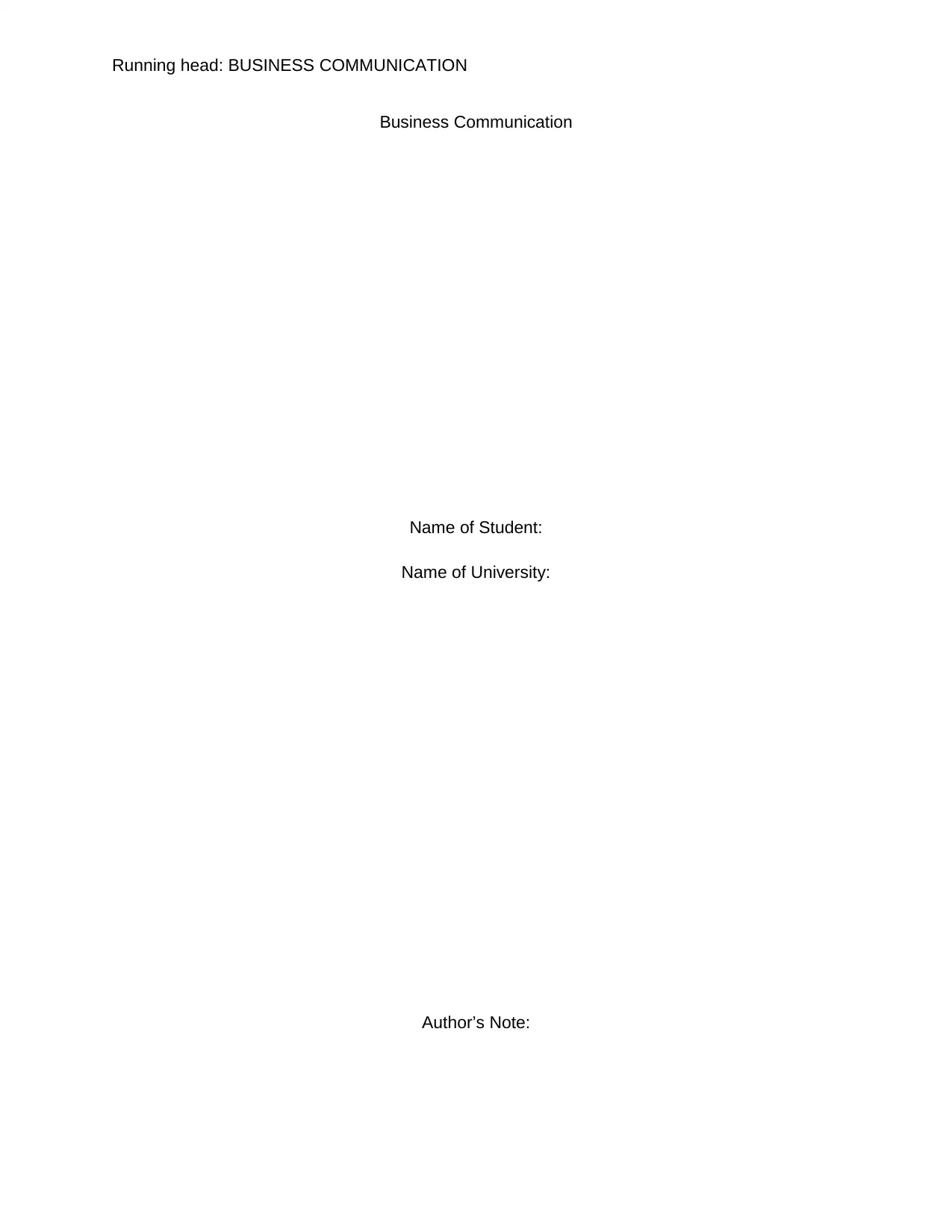
Running head: BUSINESS COMMUNICATION
Business Communication
Name of Student:
Name of University:
Author’s Note:
Business Communication
Name of Student:
Name of University:
Author’s Note:
Paraphrase This Document
Need a fresh take? Get an instant paraphrase of this document with our AI Paraphraser
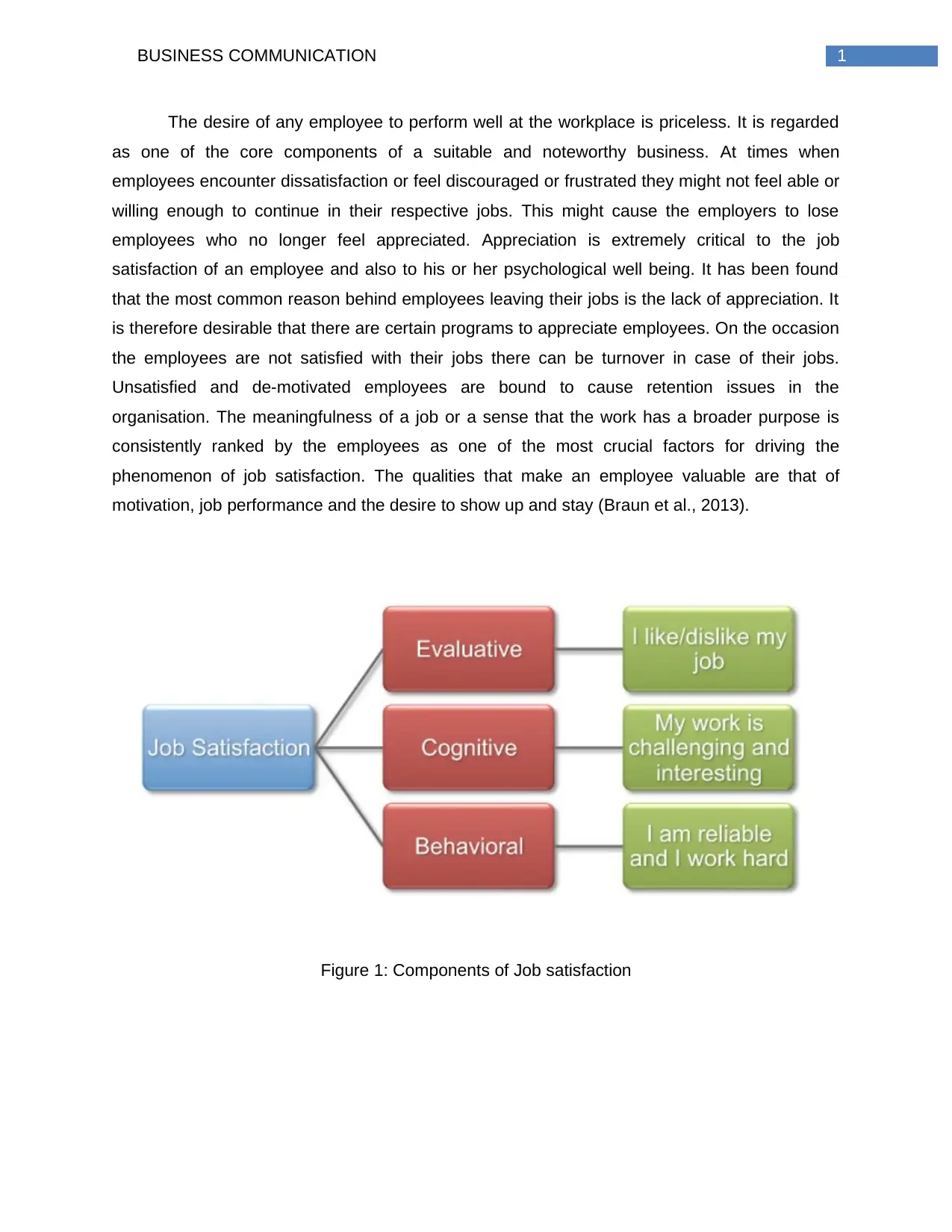
1BUSINESS COMMUNICATION
The desire of any employee to perform well at the workplace is priceless. It is regarded
as one of the core components of a suitable and noteworthy business. At times when
employees encounter dissatisfaction or feel discouraged or frustrated they might not feel able or
willing enough to continue in their respective jobs. This might cause the employers to lose
employees who no longer feel appreciated. Appreciation is extremely critical to the job
satisfaction of an employee and also to his or her psychological well being. It has been found
that the most common reason behind employees leaving their jobs is the lack of appreciation. It
is therefore desirable that there are certain programs to appreciate employees. On the occasion
the employees are not satisfied with their jobs there can be turnover in case of their jobs.
Unsatisfied and de-motivated employees are bound to cause retention issues in the
organisation. The meaningfulness of a job or a sense that the work has a broader purpose is
consistently ranked by the employees as one of the most crucial factors for driving the
phenomenon of job satisfaction. The qualities that make an employee valuable are that of
motivation, job performance and the desire to show up and stay (Braun et al., 2013).
Figure 1: Components of Job satisfaction
The desire of any employee to perform well at the workplace is priceless. It is regarded
as one of the core components of a suitable and noteworthy business. At times when
employees encounter dissatisfaction or feel discouraged or frustrated they might not feel able or
willing enough to continue in their respective jobs. This might cause the employers to lose
employees who no longer feel appreciated. Appreciation is extremely critical to the job
satisfaction of an employee and also to his or her psychological well being. It has been found
that the most common reason behind employees leaving their jobs is the lack of appreciation. It
is therefore desirable that there are certain programs to appreciate employees. On the occasion
the employees are not satisfied with their jobs there can be turnover in case of their jobs.
Unsatisfied and de-motivated employees are bound to cause retention issues in the
organisation. The meaningfulness of a job or a sense that the work has a broader purpose is
consistently ranked by the employees as one of the most crucial factors for driving the
phenomenon of job satisfaction. The qualities that make an employee valuable are that of
motivation, job performance and the desire to show up and stay (Braun et al., 2013).
Figure 1: Components of Job satisfaction

2BUSINESS COMMUNICATION
Figure 2: Job Satisfaction model
Figure 2: Job Satisfaction model
You're viewing a preview
Unlock full access by subscribing today!
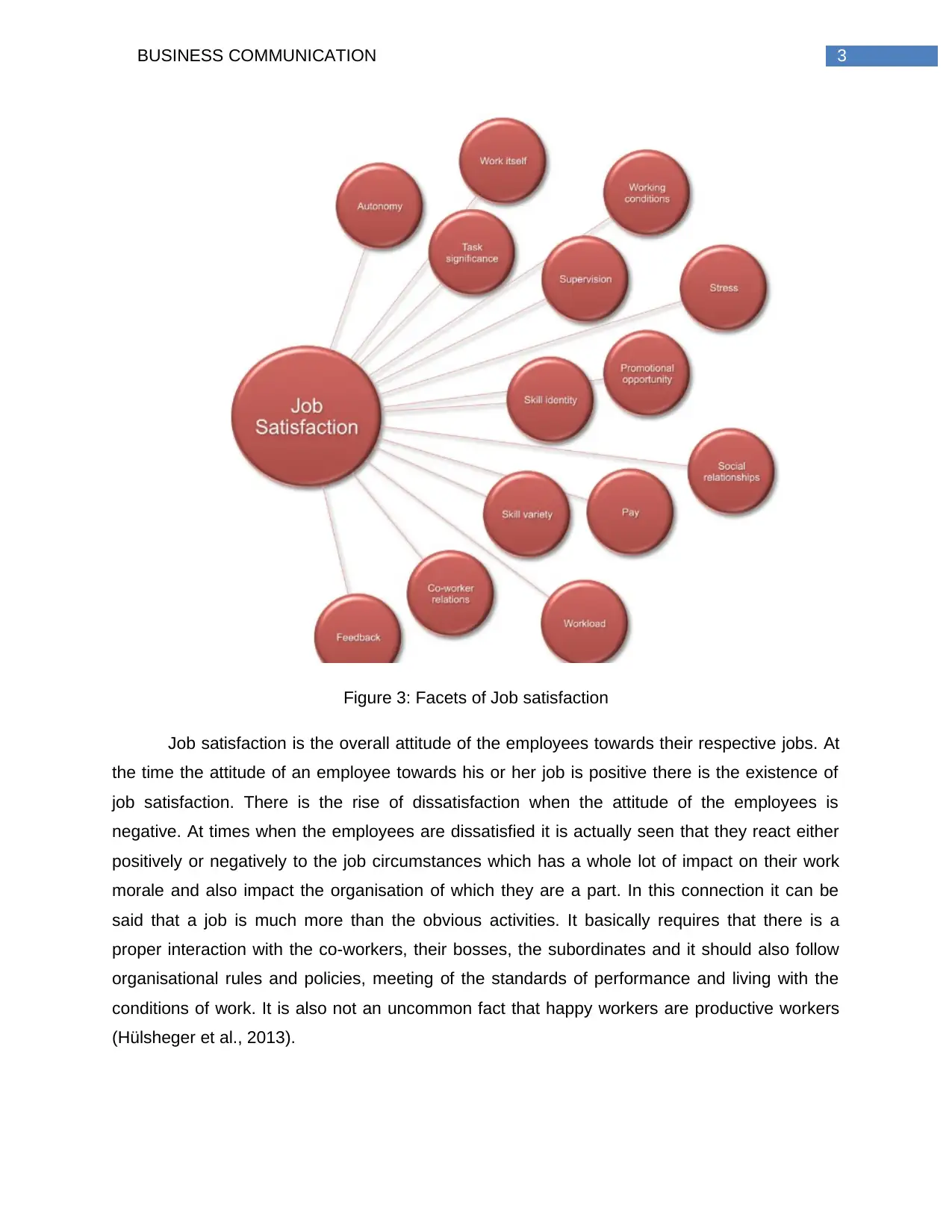
3BUSINESS COMMUNICATION
Figure 3: Facets of Job satisfaction
Job satisfaction is the overall attitude of the employees towards their respective jobs. At
the time the attitude of an employee towards his or her job is positive there is the existence of
job satisfaction. There is the rise of dissatisfaction when the attitude of the employees is
negative. At times when the employees are dissatisfied it is actually seen that they react either
positively or negatively to the job circumstances which has a whole lot of impact on their work
morale and also impact the organisation of which they are a part. In this connection it can be
said that a job is much more than the obvious activities. It basically requires that there is a
proper interaction with the co-workers, their bosses, the subordinates and it should also follow
organisational rules and policies, meeting of the standards of performance and living with the
conditions of work. It is also not an uncommon fact that happy workers are productive workers
(Hülsheger et al., 2013).
Figure 3: Facets of Job satisfaction
Job satisfaction is the overall attitude of the employees towards their respective jobs. At
the time the attitude of an employee towards his or her job is positive there is the existence of
job satisfaction. There is the rise of dissatisfaction when the attitude of the employees is
negative. At times when the employees are dissatisfied it is actually seen that they react either
positively or negatively to the job circumstances which has a whole lot of impact on their work
morale and also impact the organisation of which they are a part. In this connection it can be
said that a job is much more than the obvious activities. It basically requires that there is a
proper interaction with the co-workers, their bosses, the subordinates and it should also follow
organisational rules and policies, meeting of the standards of performance and living with the
conditions of work. It is also not an uncommon fact that happy workers are productive workers
(Hülsheger et al., 2013).
Paraphrase This Document
Need a fresh take? Get an instant paraphrase of this document with our AI Paraphraser

4BUSINESS COMMUNICATION
In the workplace the concept of employee turnover is considered to have a connotation
which is negative. This is because of the fact that the issue of employee turnover is responsible
for causing a negative impact on the image of the organisation. In case employees of an
organisation are dissatisfied the employees can cause the companies to suffer and also incur
millions of losses. The loss of revenue becomes responsible for sending the companies to
financial distress with certain companies filing for bankruptcy in extreme cases. The negligence
of the employees due to the dissatisfaction with their employer can lead to huge amount of
financial losses which are suffered by major brands and companies of different sizes (Card et
al., 2012).
On the occasion when an employee is not happy with his or her job, it is reflected clearly
in the productivity of the employees. On those situations where the employees put off their work
it implies that they do not want to do it and because of this reason the employees rush through
the process of task completion. This situation is also responsible for poor standards of quality,
unsafe products and danger to the customers. In this connection it can be said that base on the
feedback from the employees the organisations can make changes to increase the amount of
productivity, boost the morale and also improve the quality assurance standards for ensuring
that safe products, content employees, increased sales and happy customers are all reported to
the organisation (Collie, Shapka & Perry, 2012).
It also happens that dissatisfied employees often neglect the work and daily tasks which
are allotted to them. This is majorly due to their job dissatisfaction. The situation of company
negligence on any particular level often results in considerable settlements which are paid and
therefore this can damage the economic stability of a company and the company can witness a
financial downward spiral (Lu et al., 2012).
It also happens that the salaries which are not around the median for the specific role of
any employee in an industry the employees are dissatisfied and the turnover rates become
considerable for the specific company. It has been researched that the turnover rates of the
employees increase by 100 to 300 percent and also include cases when the 46% percent of
newly hired employees leave their jobs within the first 18 months of their joining a particular
organisation (Nagar, 2012).
It is seen that very little is needed to destroy the reputation of a particular company, it is
seen that in most cases the actions which are taken by employees who are displeased with their
organisation cause adverse effects on the image of the company in which they work. Depending
In the workplace the concept of employee turnover is considered to have a connotation
which is negative. This is because of the fact that the issue of employee turnover is responsible
for causing a negative impact on the image of the organisation. In case employees of an
organisation are dissatisfied the employees can cause the companies to suffer and also incur
millions of losses. The loss of revenue becomes responsible for sending the companies to
financial distress with certain companies filing for bankruptcy in extreme cases. The negligence
of the employees due to the dissatisfaction with their employer can lead to huge amount of
financial losses which are suffered by major brands and companies of different sizes (Card et
al., 2012).
On the occasion when an employee is not happy with his or her job, it is reflected clearly
in the productivity of the employees. On those situations where the employees put off their work
it implies that they do not want to do it and because of this reason the employees rush through
the process of task completion. This situation is also responsible for poor standards of quality,
unsafe products and danger to the customers. In this connection it can be said that base on the
feedback from the employees the organisations can make changes to increase the amount of
productivity, boost the morale and also improve the quality assurance standards for ensuring
that safe products, content employees, increased sales and happy customers are all reported to
the organisation (Collie, Shapka & Perry, 2012).
It also happens that dissatisfied employees often neglect the work and daily tasks which
are allotted to them. This is majorly due to their job dissatisfaction. The situation of company
negligence on any particular level often results in considerable settlements which are paid and
therefore this can damage the economic stability of a company and the company can witness a
financial downward spiral (Lu et al., 2012).
It also happens that the salaries which are not around the median for the specific role of
any employee in an industry the employees are dissatisfied and the turnover rates become
considerable for the specific company. It has been researched that the turnover rates of the
employees increase by 100 to 300 percent and also include cases when the 46% percent of
newly hired employees leave their jobs within the first 18 months of their joining a particular
organisation (Nagar, 2012).
It is seen that very little is needed to destroy the reputation of a particular company, it is
seen that in most cases the actions which are taken by employees who are displeased with their
organisation cause adverse effects on the image of the company in which they work. Depending
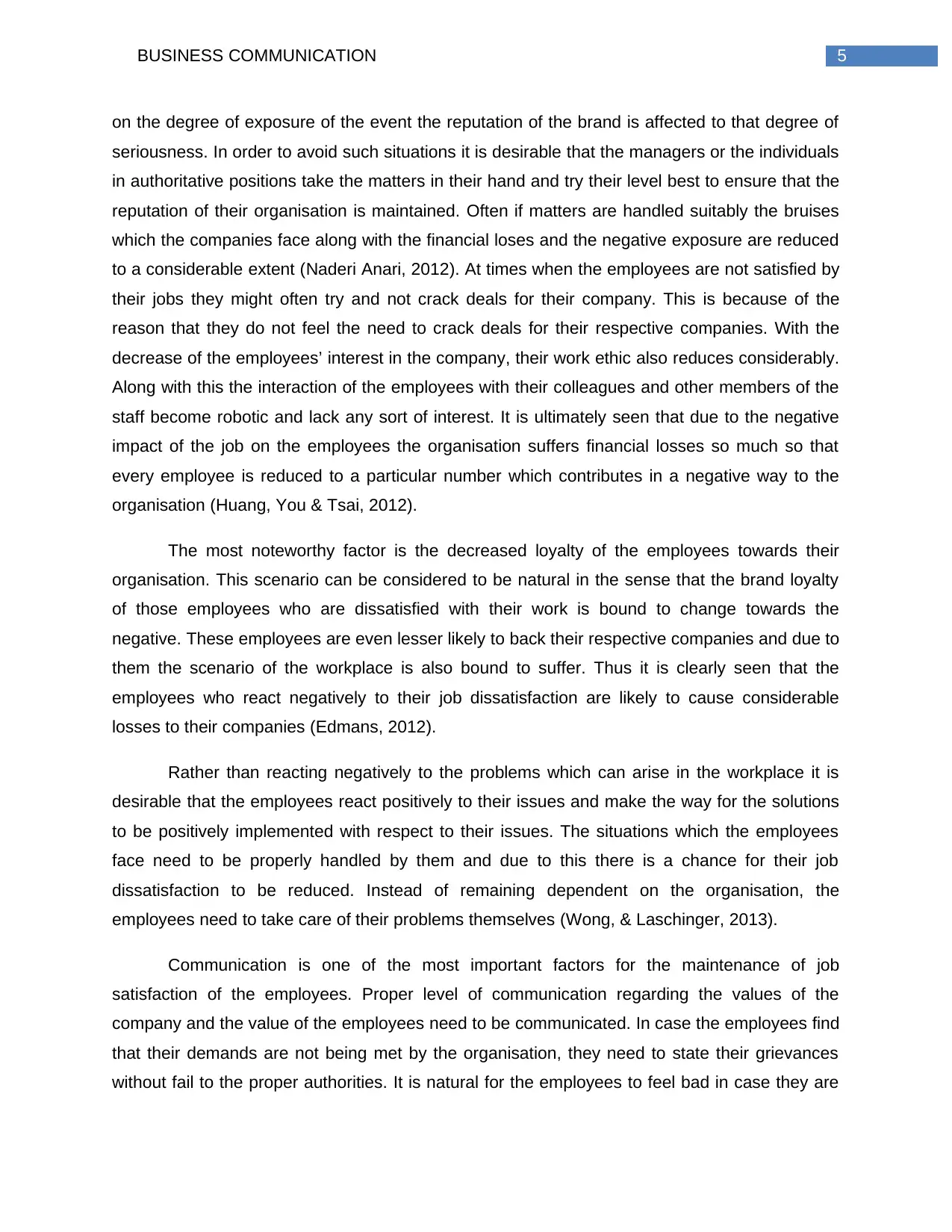
5BUSINESS COMMUNICATION
on the degree of exposure of the event the reputation of the brand is affected to that degree of
seriousness. In order to avoid such situations it is desirable that the managers or the individuals
in authoritative positions take the matters in their hand and try their level best to ensure that the
reputation of their organisation is maintained. Often if matters are handled suitably the bruises
which the companies face along with the financial loses and the negative exposure are reduced
to a considerable extent (Naderi Anari, 2012). At times when the employees are not satisfied by
their jobs they might often try and not crack deals for their company. This is because of the
reason that they do not feel the need to crack deals for their respective companies. With the
decrease of the employees’ interest in the company, their work ethic also reduces considerably.
Along with this the interaction of the employees with their colleagues and other members of the
staff become robotic and lack any sort of interest. It is ultimately seen that due to the negative
impact of the job on the employees the organisation suffers financial losses so much so that
every employee is reduced to a particular number which contributes in a negative way to the
organisation (Huang, You & Tsai, 2012).
The most noteworthy factor is the decreased loyalty of the employees towards their
organisation. This scenario can be considered to be natural in the sense that the brand loyalty
of those employees who are dissatisfied with their work is bound to change towards the
negative. These employees are even lesser likely to back their respective companies and due to
them the scenario of the workplace is also bound to suffer. Thus it is clearly seen that the
employees who react negatively to their job dissatisfaction are likely to cause considerable
losses to their companies (Edmans, 2012).
Rather than reacting negatively to the problems which can arise in the workplace it is
desirable that the employees react positively to their issues and make the way for the solutions
to be positively implemented with respect to their issues. The situations which the employees
face need to be properly handled by them and due to this there is a chance for their job
dissatisfaction to be reduced. Instead of remaining dependent on the organisation, the
employees need to take care of their problems themselves (Wong, & Laschinger, 2013).
Communication is one of the most important factors for the maintenance of job
satisfaction of the employees. Proper level of communication regarding the values of the
company and the value of the employees need to be communicated. In case the employees find
that their demands are not being met by the organisation, they need to state their grievances
without fail to the proper authorities. It is natural for the employees to feel bad in case they are
on the degree of exposure of the event the reputation of the brand is affected to that degree of
seriousness. In order to avoid such situations it is desirable that the managers or the individuals
in authoritative positions take the matters in their hand and try their level best to ensure that the
reputation of their organisation is maintained. Often if matters are handled suitably the bruises
which the companies face along with the financial loses and the negative exposure are reduced
to a considerable extent (Naderi Anari, 2012). At times when the employees are not satisfied by
their jobs they might often try and not crack deals for their company. This is because of the
reason that they do not feel the need to crack deals for their respective companies. With the
decrease of the employees’ interest in the company, their work ethic also reduces considerably.
Along with this the interaction of the employees with their colleagues and other members of the
staff become robotic and lack any sort of interest. It is ultimately seen that due to the negative
impact of the job on the employees the organisation suffers financial losses so much so that
every employee is reduced to a particular number which contributes in a negative way to the
organisation (Huang, You & Tsai, 2012).
The most noteworthy factor is the decreased loyalty of the employees towards their
organisation. This scenario can be considered to be natural in the sense that the brand loyalty
of those employees who are dissatisfied with their work is bound to change towards the
negative. These employees are even lesser likely to back their respective companies and due to
them the scenario of the workplace is also bound to suffer. Thus it is clearly seen that the
employees who react negatively to their job dissatisfaction are likely to cause considerable
losses to their companies (Edmans, 2012).
Rather than reacting negatively to the problems which can arise in the workplace it is
desirable that the employees react positively to their issues and make the way for the solutions
to be positively implemented with respect to their issues. The situations which the employees
face need to be properly handled by them and due to this there is a chance for their job
dissatisfaction to be reduced. Instead of remaining dependent on the organisation, the
employees need to take care of their problems themselves (Wong, & Laschinger, 2013).
Communication is one of the most important factors for the maintenance of job
satisfaction of the employees. Proper level of communication regarding the values of the
company and the value of the employees need to be communicated. In case the employees find
that their demands are not being met by the organisation, they need to state their grievances
without fail to the proper authorities. It is natural for the employees to feel bad in case they are
You're viewing a preview
Unlock full access by subscribing today!
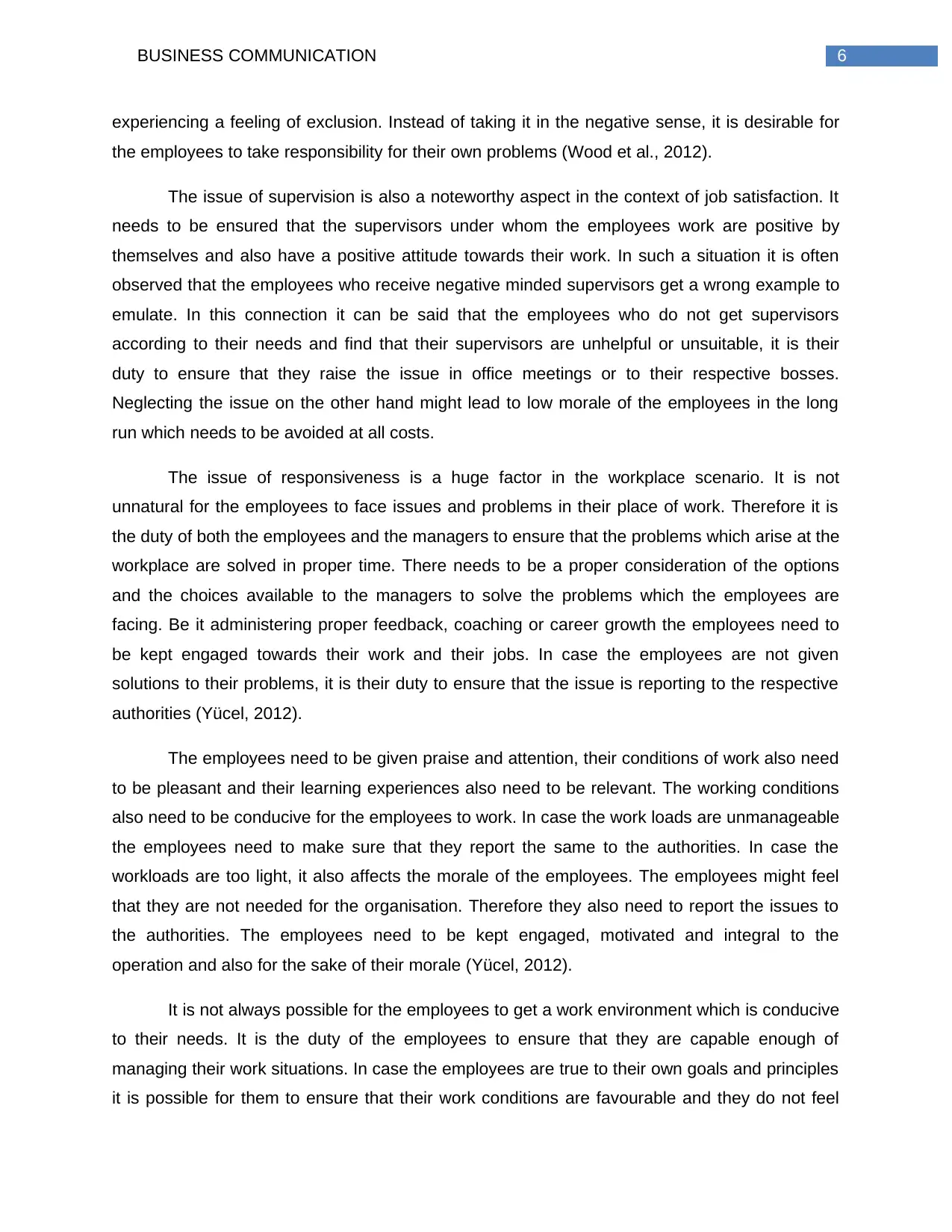
6BUSINESS COMMUNICATION
experiencing a feeling of exclusion. Instead of taking it in the negative sense, it is desirable for
the employees to take responsibility for their own problems (Wood et al., 2012).
The issue of supervision is also a noteworthy aspect in the context of job satisfaction. It
needs to be ensured that the supervisors under whom the employees work are positive by
themselves and also have a positive attitude towards their work. In such a situation it is often
observed that the employees who receive negative minded supervisors get a wrong example to
emulate. In this connection it can be said that the employees who do not get supervisors
according to their needs and find that their supervisors are unhelpful or unsuitable, it is their
duty to ensure that they raise the issue in office meetings or to their respective bosses.
Neglecting the issue on the other hand might lead to low morale of the employees in the long
run which needs to be avoided at all costs.
The issue of responsiveness is a huge factor in the workplace scenario. It is not
unnatural for the employees to face issues and problems in their place of work. Therefore it is
the duty of both the employees and the managers to ensure that the problems which arise at the
workplace are solved in proper time. There needs to be a proper consideration of the options
and the choices available to the managers to solve the problems which the employees are
facing. Be it administering proper feedback, coaching or career growth the employees need to
be kept engaged towards their work and their jobs. In case the employees are not given
solutions to their problems, it is their duty to ensure that the issue is reporting to the respective
authorities (Yücel, 2012).
The employees need to be given praise and attention, their conditions of work also need
to be pleasant and their learning experiences also need to be relevant. The working conditions
also need to be conducive for the employees to work. In case the work loads are unmanageable
the employees need to make sure that they report the same to the authorities. In case the
workloads are too light, it also affects the morale of the employees. The employees might feel
that they are not needed for the organisation. Therefore they also need to report the issues to
the authorities. The employees need to be kept engaged, motivated and integral to the
operation and also for the sake of their morale (Yücel, 2012).
It is not always possible for the employees to get a work environment which is conducive
to their needs. It is the duty of the employees to ensure that they are capable enough of
managing their work situations. In case the employees are true to their own goals and principles
it is possible for them to ensure that their work conditions are favourable and they do not feel
experiencing a feeling of exclusion. Instead of taking it in the negative sense, it is desirable for
the employees to take responsibility for their own problems (Wood et al., 2012).
The issue of supervision is also a noteworthy aspect in the context of job satisfaction. It
needs to be ensured that the supervisors under whom the employees work are positive by
themselves and also have a positive attitude towards their work. In such a situation it is often
observed that the employees who receive negative minded supervisors get a wrong example to
emulate. In this connection it can be said that the employees who do not get supervisors
according to their needs and find that their supervisors are unhelpful or unsuitable, it is their
duty to ensure that they raise the issue in office meetings or to their respective bosses.
Neglecting the issue on the other hand might lead to low morale of the employees in the long
run which needs to be avoided at all costs.
The issue of responsiveness is a huge factor in the workplace scenario. It is not
unnatural for the employees to face issues and problems in their place of work. Therefore it is
the duty of both the employees and the managers to ensure that the problems which arise at the
workplace are solved in proper time. There needs to be a proper consideration of the options
and the choices available to the managers to solve the problems which the employees are
facing. Be it administering proper feedback, coaching or career growth the employees need to
be kept engaged towards their work and their jobs. In case the employees are not given
solutions to their problems, it is their duty to ensure that the issue is reporting to the respective
authorities (Yücel, 2012).
The employees need to be given praise and attention, their conditions of work also need
to be pleasant and their learning experiences also need to be relevant. The working conditions
also need to be conducive for the employees to work. In case the work loads are unmanageable
the employees need to make sure that they report the same to the authorities. In case the
workloads are too light, it also affects the morale of the employees. The employees might feel
that they are not needed for the organisation. Therefore they also need to report the issues to
the authorities. The employees need to be kept engaged, motivated and integral to the
operation and also for the sake of their morale (Yücel, 2012).
It is not always possible for the employees to get a work environment which is conducive
to their needs. It is the duty of the employees to ensure that they are capable enough of
managing their work situations. In case the employees are true to their own goals and principles
it is possible for them to ensure that their work conditions are favourable and they do not feel
Paraphrase This Document
Need a fresh take? Get an instant paraphrase of this document with our AI Paraphraser
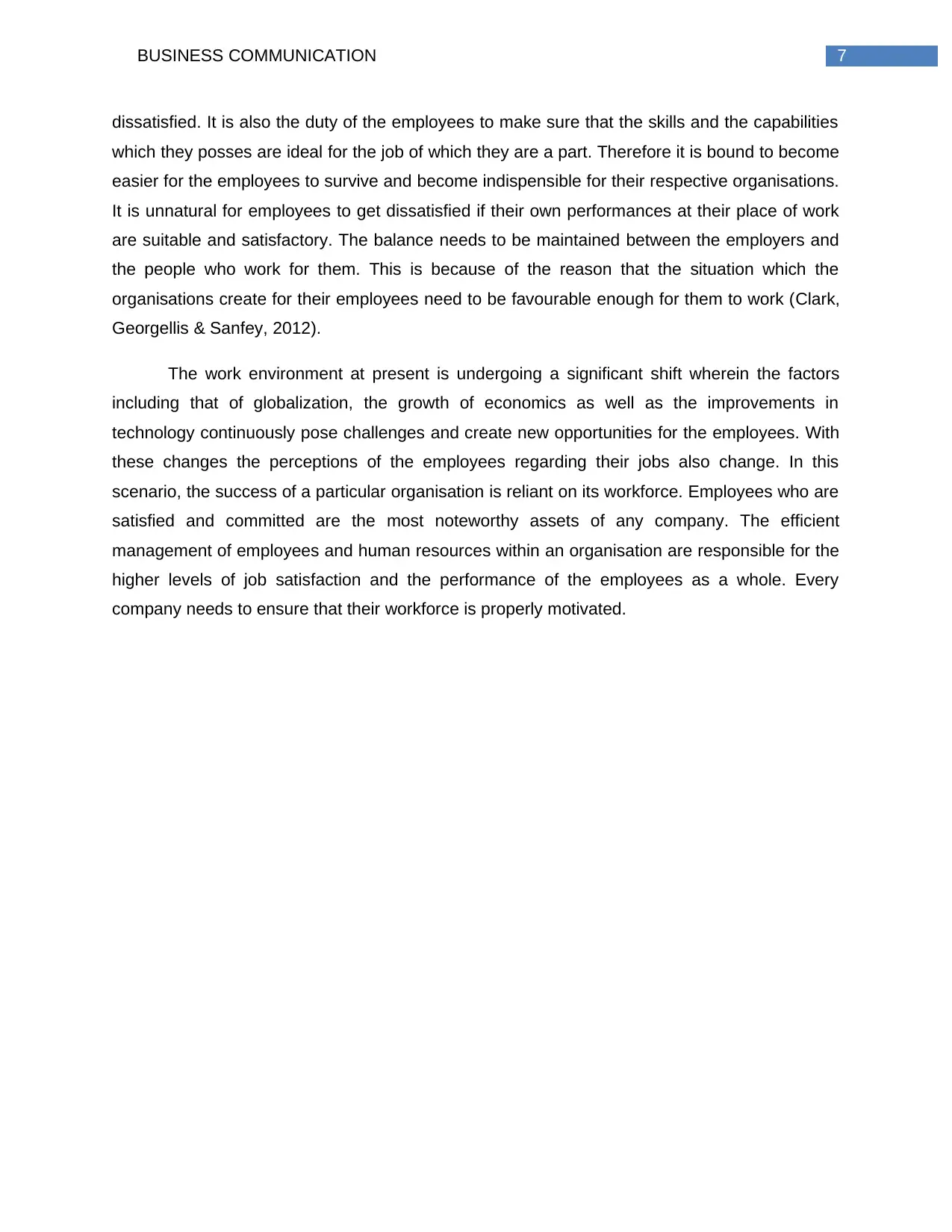
7BUSINESS COMMUNICATION
dissatisfied. It is also the duty of the employees to make sure that the skills and the capabilities
which they posses are ideal for the job of which they are a part. Therefore it is bound to become
easier for the employees to survive and become indispensible for their respective organisations.
It is unnatural for employees to get dissatisfied if their own performances at their place of work
are suitable and satisfactory. The balance needs to be maintained between the employers and
the people who work for them. This is because of the reason that the situation which the
organisations create for their employees need to be favourable enough for them to work (Clark,
Georgellis & Sanfey, 2012).
The work environment at present is undergoing a significant shift wherein the factors
including that of globalization, the growth of economics as well as the improvements in
technology continuously pose challenges and create new opportunities for the employees. With
these changes the perceptions of the employees regarding their jobs also change. In this
scenario, the success of a particular organisation is reliant on its workforce. Employees who are
satisfied and committed are the most noteworthy assets of any company. The efficient
management of employees and human resources within an organisation are responsible for the
higher levels of job satisfaction and the performance of the employees as a whole. Every
company needs to ensure that their workforce is properly motivated.
dissatisfied. It is also the duty of the employees to make sure that the skills and the capabilities
which they posses are ideal for the job of which they are a part. Therefore it is bound to become
easier for the employees to survive and become indispensible for their respective organisations.
It is unnatural for employees to get dissatisfied if their own performances at their place of work
are suitable and satisfactory. The balance needs to be maintained between the employers and
the people who work for them. This is because of the reason that the situation which the
organisations create for their employees need to be favourable enough for them to work (Clark,
Georgellis & Sanfey, 2012).
The work environment at present is undergoing a significant shift wherein the factors
including that of globalization, the growth of economics as well as the improvements in
technology continuously pose challenges and create new opportunities for the employees. With
these changes the perceptions of the employees regarding their jobs also change. In this
scenario, the success of a particular organisation is reliant on its workforce. Employees who are
satisfied and committed are the most noteworthy assets of any company. The efficient
management of employees and human resources within an organisation are responsible for the
higher levels of job satisfaction and the performance of the employees as a whole. Every
company needs to ensure that their workforce is properly motivated.
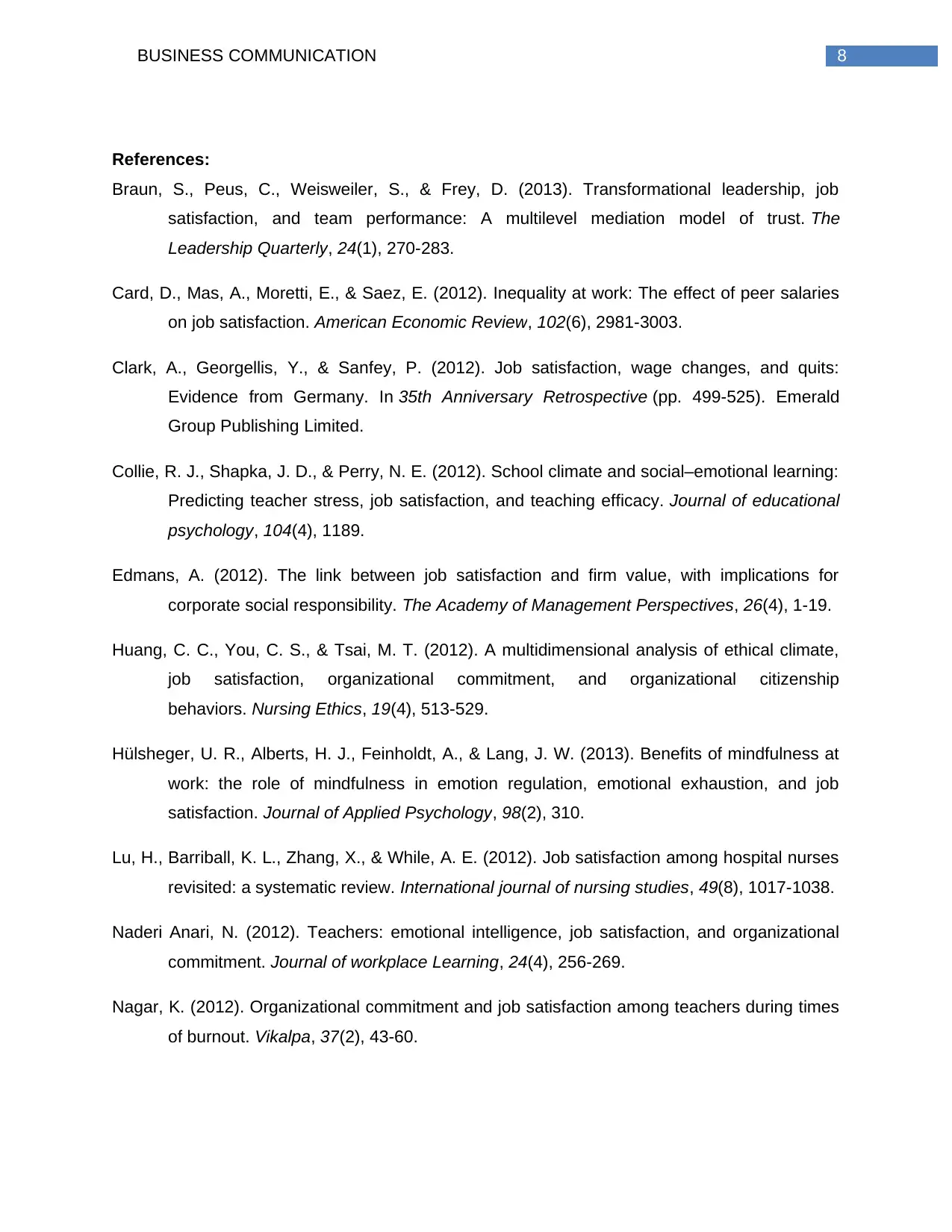
8BUSINESS COMMUNICATION
References:
Braun, S., Peus, C., Weisweiler, S., & Frey, D. (2013). Transformational leadership, job
satisfaction, and team performance: A multilevel mediation model of trust. The
Leadership Quarterly, 24(1), 270-283.
Card, D., Mas, A., Moretti, E., & Saez, E. (2012). Inequality at work: The effect of peer salaries
on job satisfaction. American Economic Review, 102(6), 2981-3003.
Clark, A., Georgellis, Y., & Sanfey, P. (2012). Job satisfaction, wage changes, and quits:
Evidence from Germany. In 35th Anniversary Retrospective (pp. 499-525). Emerald
Group Publishing Limited.
Collie, R. J., Shapka, J. D., & Perry, N. E. (2012). School climate and social–emotional learning:
Predicting teacher stress, job satisfaction, and teaching efficacy. Journal of educational
psychology, 104(4), 1189.
Edmans, A. (2012). The link between job satisfaction and firm value, with implications for
corporate social responsibility. The Academy of Management Perspectives, 26(4), 1-19.
Huang, C. C., You, C. S., & Tsai, M. T. (2012). A multidimensional analysis of ethical climate,
job satisfaction, organizational commitment, and organizational citizenship
behaviors. Nursing Ethics, 19(4), 513-529.
Hülsheger, U. R., Alberts, H. J., Feinholdt, A., & Lang, J. W. (2013). Benefits of mindfulness at
work: the role of mindfulness in emotion regulation, emotional exhaustion, and job
satisfaction. Journal of Applied Psychology, 98(2), 310.
Lu, H., Barriball, K. L., Zhang, X., & While, A. E. (2012). Job satisfaction among hospital nurses
revisited: a systematic review. International journal of nursing studies, 49(8), 1017-1038.
Naderi Anari, N. (2012). Teachers: emotional intelligence, job satisfaction, and organizational
commitment. Journal of workplace Learning, 24(4), 256-269.
Nagar, K. (2012). Organizational commitment and job satisfaction among teachers during times
of burnout. Vikalpa, 37(2), 43-60.
References:
Braun, S., Peus, C., Weisweiler, S., & Frey, D. (2013). Transformational leadership, job
satisfaction, and team performance: A multilevel mediation model of trust. The
Leadership Quarterly, 24(1), 270-283.
Card, D., Mas, A., Moretti, E., & Saez, E. (2012). Inequality at work: The effect of peer salaries
on job satisfaction. American Economic Review, 102(6), 2981-3003.
Clark, A., Georgellis, Y., & Sanfey, P. (2012). Job satisfaction, wage changes, and quits:
Evidence from Germany. In 35th Anniversary Retrospective (pp. 499-525). Emerald
Group Publishing Limited.
Collie, R. J., Shapka, J. D., & Perry, N. E. (2012). School climate and social–emotional learning:
Predicting teacher stress, job satisfaction, and teaching efficacy. Journal of educational
psychology, 104(4), 1189.
Edmans, A. (2012). The link between job satisfaction and firm value, with implications for
corporate social responsibility. The Academy of Management Perspectives, 26(4), 1-19.
Huang, C. C., You, C. S., & Tsai, M. T. (2012). A multidimensional analysis of ethical climate,
job satisfaction, organizational commitment, and organizational citizenship
behaviors. Nursing Ethics, 19(4), 513-529.
Hülsheger, U. R., Alberts, H. J., Feinholdt, A., & Lang, J. W. (2013). Benefits of mindfulness at
work: the role of mindfulness in emotion regulation, emotional exhaustion, and job
satisfaction. Journal of Applied Psychology, 98(2), 310.
Lu, H., Barriball, K. L., Zhang, X., & While, A. E. (2012). Job satisfaction among hospital nurses
revisited: a systematic review. International journal of nursing studies, 49(8), 1017-1038.
Naderi Anari, N. (2012). Teachers: emotional intelligence, job satisfaction, and organizational
commitment. Journal of workplace Learning, 24(4), 256-269.
Nagar, K. (2012). Organizational commitment and job satisfaction among teachers during times
of burnout. Vikalpa, 37(2), 43-60.
You're viewing a preview
Unlock full access by subscribing today!
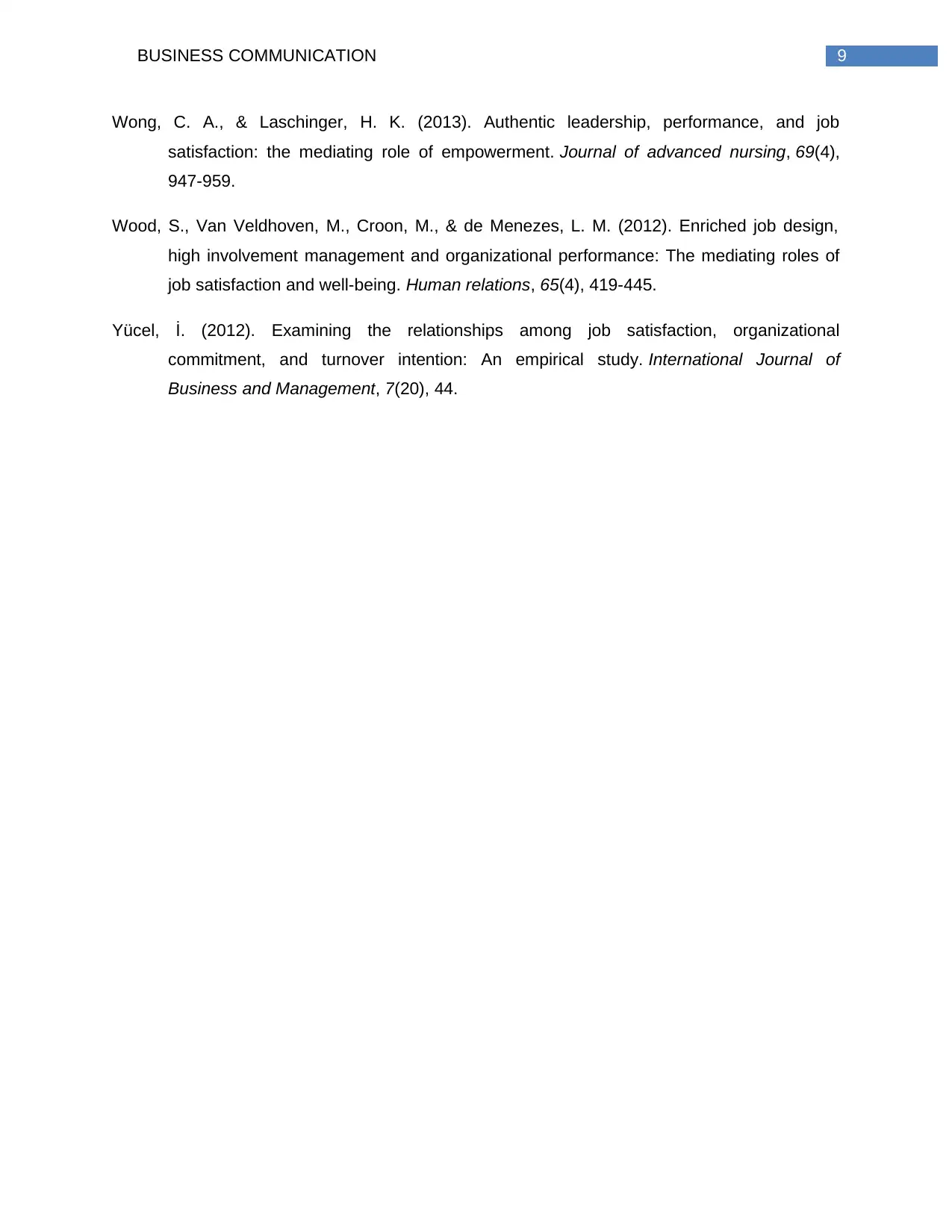
9BUSINESS COMMUNICATION
Wong, C. A., & Laschinger, H. K. (2013). Authentic leadership, performance, and job
satisfaction: the mediating role of empowerment. Journal of advanced nursing, 69(4),
947-959.
Wood, S., Van Veldhoven, M., Croon, M., & de Menezes, L. M. (2012). Enriched job design,
high involvement management and organizational performance: The mediating roles of
job satisfaction and well-being. Human relations, 65(4), 419-445.
Yücel, İ. (2012). Examining the relationships among job satisfaction, organizational
commitment, and turnover intention: An empirical study. International Journal of
Business and Management, 7(20), 44.
Wong, C. A., & Laschinger, H. K. (2013). Authentic leadership, performance, and job
satisfaction: the mediating role of empowerment. Journal of advanced nursing, 69(4),
947-959.
Wood, S., Van Veldhoven, M., Croon, M., & de Menezes, L. M. (2012). Enriched job design,
high involvement management and organizational performance: The mediating roles of
job satisfaction and well-being. Human relations, 65(4), 419-445.
Yücel, İ. (2012). Examining the relationships among job satisfaction, organizational
commitment, and turnover intention: An empirical study. International Journal of
Business and Management, 7(20), 44.
1 out of 10
Related Documents
Your All-in-One AI-Powered Toolkit for Academic Success.
+13062052269
info@desklib.com
Available 24*7 on WhatsApp / Email
![[object Object]](/_next/static/media/star-bottom.7253800d.svg)
Unlock your academic potential
© 2024 | Zucol Services PVT LTD | All rights reserved.





